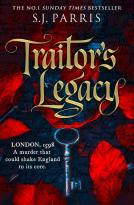
Ravenna
Capital of Empire, Crucible of Europe
by Judith Herrin
This title was previously available on NetGalley and is now archived.
Send NetGalley books directly to your Kindle or Kindle app
1
To read on a Kindle or Kindle app, please add kindle@netgalley.com as an approved email address to receive files in your Amazon account. Click here for step-by-step instructions.
2
Also find your Kindle email address within your Amazon account, and enter it here.
Pub Date 27 Aug 2020 | Archive Date 16 Dec 2020
Talking about this book? Use #Ravenna #NetGalley. More hashtag tips!
Description
'Magisterial - an outstanding book that shines a bright light ON one of the most important, interesting and under-studied cities in European history. A masterpiece.' Peter Frankopan
'A wonderful new history of the Mediterranean from the fifth to eighth centuries through a lens focussed on Ravenna, gracefully and clearly written, which reconceptualizes what was "East" and what was "West".' Caroline Goodson
'A masterwork by one of our greatest historians of Byzantium and early Christianity. Judith Herrin tells a story that is at once gripping and authoritative and full of wonderful detail about every element in the life of Ravenna. Impossible to put down.' David Freedberg
In 402 AD, after invading tribes broke through the Alpine frontiers of Italy and threatened the imperial government in Milan, the young Emperor Honorius made the momentous decision to move his capital to a small, easy defendable city in the Po estuary - Ravenna. From then until 751 AD, Ravenna was first the capital of the Western Roman Empire, then that of the immense kingdom of Theoderic the Goth and finally the centre of Byzantine power in Italy.
In this engrossing account Judith Herrin explains how scholars, lawyers, doctors, craftsmen, cosmologists and religious luminaries were drawn to Ravenna where they created a cultural and political capital that dominated northern Italy and the Adriatic. As she traces the lives of Ravenna's rulers, chroniclers and inhabitants, Herrin shows how the city became the meeting place of Greek, Latin, Christian and barbarian cultures and the pivot between East and West. The book offers a fresh account of the waning of Rome, the Gothic and Lombard invasions, the rise of Islam and the devastating divisions within Christianity. It argues that the fifth to eighth centuries should not be perceived as a time of decline from antiquity but rather, thanks to Byzantium, as one of great creativity - the period of 'Early Christendom'. These were the formative centuries of Europe.
While Ravenna's palaces have crumbled, its churches have survived. In them, Catholic Romans and Arian Goths competed to produce an unrivalled concentration of spectacular mosaics, many of which still astonish visitors today. Beautifully illustrated with specially commissioned photographs, and drawing on the latest archaeological and documentary discoveries, Ravenna: Capital of Empire, Crucible of Europe brings the early Middle Ages to life through the history of this dazzling city.
Available Editions
| EDITION | Hardcover |
| ISBN | 9781846144660 |
| PRICE | £30.00 (GBP) |
| PAGES | 544 |
Featured Reviews
Anyone like me who rather shamefully has a historical blank when it comes to that time between the decline of the classical period and the start of the medieval, would do well to pick up this book. Herrin offers up a detailed historical narrative that charts not just the role of Ravenna as imperial capital of the west, but also navigates us surely through the complications of Goth invasions, the decline of Rome, Constantinople/Byzantium, and the complicated rise of Christianity.
After a brief introduction, it opens with Galla Placidia in the late fourth century and her extraordinary story of kidnapping and marriage before she emerges as empress mother. Following the emperors in linear fashion, this closes with the age of Charlemagne in the eighth century.
Along the way, we meet bishops and archbishops, Goths and Ostrogoths, Arab conquests and Church councils, Justinian and Belisarius. There's perhaps too much on the in-fighting of church factions over issues of creed for my taste but there's no question that this needs to be here. I also thought there would be more on the architecture and art of Ravenna but sadly so many of the buildings have been lost along with documentary sources.
Considering the paucity of primary sources and the Christianised bias of those that exist, Herrin has done an exemplary job of making the story flow. This is aimed as a peer group of historians but is readable and accessible by non-experts wanting a reliable, detailed and properly-referenced history of this period.
Readers who liked this book also liked:
Rick Riordan; Mark Oshiro
Children's Fiction, LGBTQIA, Teens & YA


















